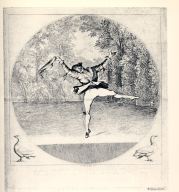 Men en Pointe
Men en Pointe
While the first occurrence of a dancer en pointe is nearly impossible to accurately identify, in 1779 Gennaro Magri writes about the performance of a dancer who rises to full point and it is indeed a man. In his Theatrical Treatise of the Art of Dancing, Magri relates how Antoine Pitrot raised “his whole body on the tip of his big toe, [extending] all the joints so perfectly, that the whole thigh, leg and foot itself [fell] into one perpendicular line.” It would be several decades before there would be discussion of a woman performing the same feat. It is significant that despite its ostensible beginnings as a male achievement, pointe work becomes the sole accoutrement of the female dancer. To understand why this is, we shall have to take a closer look at ideologies surrounding prescribed notions of gender that were circulating in the early- and mid-nineteenth century.